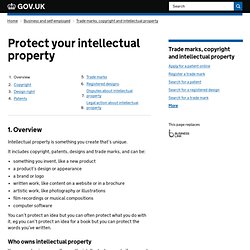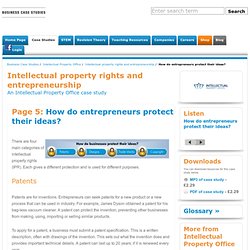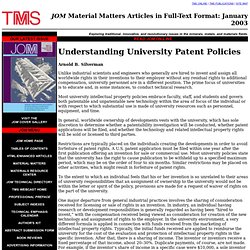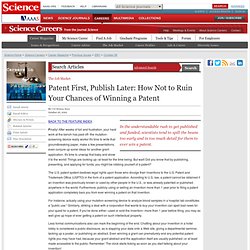

WHAT. What are Intellectual Propery Rights? Introduction to IP. People have ideas all the time.

In business, new ideas can lead to new products and services. They can lead to a better way of doing something. Ideas can come from existing businesses through research and development. For example, Apple, an established technology company, developed the iPod. Ideas generate value to the economy by encouraging people to buy or invest in new developments. Intellectual property rights (IPR) can be used to protect the technology, brand name, design and creativity behind the concept.
The UK Intellectual Property Office (UK IPO) helps owners and entrepreneurs to protect their concepts or creativity by registering their intellectual property rights. WHY.
Importance of IP protection for business. Intellectual property is something you create that’s unique.

It includes copyright, patents, designs and trade marks, and can be: something you invent, like a new product a product’s design or appearance a brand or logo written work, like content on a website or in a brochure artistic work, like photography or illustrations film recordings or musical compositions computer software You can’t protect an idea but you can often protect what you do with it, eg you can’t protect an idea for a book but you can protect the words you’ve written. Who owns intellectual property You or your business usually own the intellectual property if you create something.
Contracts with employees and subcontractor should say who owns the intellectual property of anything they create for you. Protecting your intellectual property allows you to: stop others using what you’ve created without your permission charge others for the right to use what you’ve created Types of protection. Protecting Inventions Abroad FAQ. How do entrepreneurs protect IP? There are four main categories of intellectual property rights (IPR).

Each gives a different protection and is used for different purposes. Patents Patents are for inventions. Entrepreneurs can seek patents for a new product or a new process that can be used in industry. For example, James Dyson obtained a patent for his bag-less vacuum cleaner. To apply for a patent, a business must submit a patent specification. Designs Registering a design prevents a competitor copying the physical appearance of a product or component.
A registered design lasts initially for five years, although it can be renewed for up to 25 years. Trade marks A trade mark is a sign that can distinguish goods and services from those of other traders. Distinctive for a group of goods and servicesnot the same as (or similar to) any earlier marks on the register for the same or similar goods and services A trade mark is a marketing tool which helps to develop and distinguish the brand. Copyright. Understanding University Patent Policies. Arnold B.

Silverman Unlike industrial scientists and engineers who generally are hired to invent and assign all worldwide rights in their inventions to their employer without any residual rights to additional compensation, university personnel are in a different position. The prime focus of universities is to educate and, in some instances, to conduct technical research. Most university intellectual property policies embrace faculty, staff, and students and govern both patentable and unpatentable new technology within the area of focus of the individual or with respect to which substantial use is made of university resources such as personnel, equipment, and time.
In general, worldwide ownership of developments vests with the university, which has sole discretion to determine whether a patentability investigation will be conducted, whether patent applications will be filed, and whether the technology and related intellectual property rights will be sold or licensed to third parties. Iowa State U: Best Practices to Protect IP. Patent First, Publish Later. Finally!

After weeks of toil and frustration, your hard work at the bench has paid off--the mutation-screening device really works! It's time to write that groundbreaking paper, make a few presentations, even conjure up some ideas for another grant application. It's time to unwrap that baby and show it to the world! Things are looking up--at least for the time being. But wait! The U.S. patent system bestows legal rights upon those who divulge their inventions to the U.S. For instance, actually using your mutation-screening device to analyze blood samples in a hospital lab constitutes a "public use.
" Less formal communications also can mark the beginning of the end: Chatting about your invention in a hotel lobby is considered a public disclosure, as is slapping your data onto a Web site, giving a departmental seminar, tacking up a poster, or publishing an abstract. But to flourish in the scientific community, you must continue to publish papers, present at meetings, and win grants. Library Services.